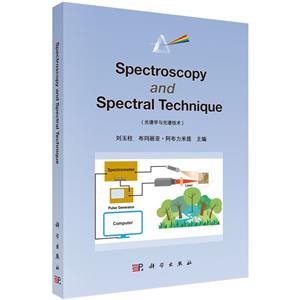扫一扫
关注中图网
官方微博
本类五星书更多>
-
>
中医基础理论
-
>
高校军事课教程
-
>
思想道德与法治(2021年版)
-
>
毛泽东思想和中国特色社会主义理论体系概论(2021年版)
-
>
中医内科学·全国中医药行业高等教育“十四五”规划教材
-
>
中医诊断学--新世纪第五版
-
>
中药学·全国中医药行业高等教育“十四五”规划教材
光谱学与光谱技术(英文版)(SPECTROSCOPY AND SPECTRAL TECHNIQUE) 版权信息
- ISBN:9787030784650
- 条形码:9787030784650 ; 978-7-03-078465-0
- 装帧:平装
- 册数:暂无
- 重量:暂无
- 所属分类:>
光谱学与光谱技术(英文版)(SPECTROSCOPY AND SPECTRAL TECHNIQUE) 内容简介
本书首先系统介绍了光谱学的基础概念,包括其起源与发展、原子和分子光谱。接着,详细探讨了11种典型的光谱技术,如激光诱导击穿光谱、拉曼光谱、红外光谱等,包括其原理、实验系统及前沿应用。随后,阐述了如何在材料、环境和工业生产等领域中结合应用多种光谱技术,以及其与单一技术相比的优势。本书还独特地介绍了基于机器学习的人工智能与光谱技术的结合应用。作为一大特色,结合*新科研成果,本书系统设计了多项光谱仿真实验项目。*后,本书展望了光谱学与光谱技术未来的发展趋势。
光谱学与光谱技术(英文版)(SPECTROSCOPY AND SPECTRAL TECHNIQUE) 目录
ContentsChapter 1 Overview of Spectral Techniques 11.1 The Origin of Spectral Techniques 11.1.1 Spectrum and Spectroscopy 11.1.2 The History of Spectral Techniques 11.2 The Development of Spectroscopy Instruments 31.2.1 The Development of Spectroscopic Theory 31.2.2 The Advent of the Laser 41.2.3 Development of Spectrometers 51.3 Atomic Energy Levels and Atomic Spectrum 51.3.1 Atomic Energy Level 51.3.2 Atomic Emission Spectroscopy 61.3.3 Atomic Absorption Spectrum 81.4 Molecular Spectrum 91.4.1 Molecular Vibrational Energy Levels and Corresponding Spectral Techniques 101.4.2 Molecular Electrons Moving Energy Levels and Corresponding Spectral Techniques 11References 12Chapter 2 Laser-induced Breakdown Spectroscopy 152.1 Birth and Development of LIBS 152.2 Fundamentals of LIBS 172.2.1 Laser-induced Plasma 172.2.2 Local Thermodynamic Equilibrium 182.2.3 Plasma Temperature and Electron Number Density 192.2.4 Qualitative and Quantitative Analysis 202.3 Instrumentation for LIBS 212.3.1 LIBS Experimental Setup 212.3.2 Online/In Situ LIBS Instruments 222.3.3 Signal Enhancement for LIBS 232.4 LIBS Applications 252.4.1 Environmental Monitoring 252.4.2 Coal Analysis 272.4.3 Biomedicine 292.4.4 Agriculture and Food Safety 312.4.5 Space Exploration 322.4.6 Ocean Exploration 34References 35Chapter 3 Raman Spectroscopy Technology 413.1 Birth and Development of Raman Spectroscopy 413.1.1 The Great Founder 413.1.2 The Birth of Raman Spectroscopy Technology 413.1.3 The Development of Raman Spectroscopy Technology 423.2 Principle of Inelastic Scattering 423.2.1 Nonconservation of the Kinetic Energy of Particles 423.2.2 Elastic and Inelastic Scattering 433.2.3 Raman Scattering and Rayleigh Scattering 433.2.4 Stokes and Anti-Stokes Lines 463.3 Experimental Systems for Raman Spectroscopy 503.3.1 The Source and Splitting of the Light 503.3.2 Collection and Monitoring 533.4 Surface-Enhanced Raman Spectroscopy 543.4.1 Defects of Ordinary Raman Spectroscopy 543.4.2 Principles of Surface-Enhanced Raman Spectroscopy 553.5 Important Applications of Raman Spectroscopy 563.5.1 Spectral Fingerprint 563.5.2 Real-time Detection of Liquid Phase Raman Spectroscopy Experiment 593.5.3 Configuration Analysis of Raman 62References 64Chapter 4 Differential Optical Absorption Spectroscopy 684.1 Development of DOAS 684.1.1 Development of DO AS Abroad 684.1.2 Domestic DOAS Development 694.1.3 Opportunities and Challenges 704.2 Principle of DOAS 714.2.1 Lambert-Beer,s Law 714.2.2 Advantages of DOAS 724.3 Experimental System of DOAS 734.3.1 Active DOAS System 734.3.2 Passive DOAS System (MAX-DOAS) 744.4 DOAS for Multi-platform 754.4.1 D OAS for the Ground Platform 754.4.2 DOAS for Mobile Platforms 764.4.3 Multi-platform Joint Application 774.5 Important Applications of DOAS 774.5.1 The Global Ozone Monitoring Experiment (GOME) 774.5.2 Gaofen-5 Satellite and Atmospheric Pollution Component Inversion Method 784.5.3 Determination of Plume from the Pollution Source 784.5.4 Planar Array Measurements of Volcanic Plumes 794.5.5 Comprehensive Stereoscopic Observation Network 80References 81Chapter 5 Infrared Spectroscopy 865.1 Background Introduction of Infrared Spectroscopy 865.1.1 Infrared Radiation 865.1.2 IR Region 875.1.3 Development of IR Spectroscopy 875.2 Principle of IR Spectroscopy 875.2.1 Principle and Characteristics of IR Spectroscopy 875.2.2 Infrared Spectrometer 885.3 Fourier Transform Infrared Spectroscopy 895.3.1 Introduction to FTIR 895.3.2 Principle of FTIR Spectroscopy 895.4 Application of IR Spectroscopy 905.4.1 IR Spectroscopy and Environmental Monitoring 905.4.2 IR Spectroscopy and Food Detection 935.4.3 IR Spectroscopy and Microbiological Analyses 955.4.4 IR Spectroscopy and Agriculture 975.4.5 IR Spectroscopy and Forensic Analysis 100References 104Chapter 6 Laser-induced Fluorescence Spectroscopy 1076.1 Introduction to Fluorescence Spectroscopy 1076.1.1 The History of Fluorescence Spectroscopy 1076.1.2 Characteristics of Fluorescence Spectroscopy 1086.1.3 Traditional Fluorescence Spectroscopy and Laser-induced Fluorescence Spectroscopy 1106.2 The Technical Basis of Laser-induced Fluorescence 1116.2.1 The Principle of Laser-induced Fluorescence 1116.2.2 Affected Factors of Fluorescence 1136.2.3 The Development of LIF Technology 1146.3 Experimental System of LIF Spectroscopy 1156.3.1 Excitation Light Sources 1156.3.2 Detector 1166.4 Important Applications of LIF 1176.4.1 On-line Detection of Carbon Isotopes Based on LIF Spectroscopy of CN Radicals 1176.4.2 Applications of LIF in Soils and Sediments 12
展开全部
书友推荐
- >
伯纳黛特,你要去哪(2021新版)
伯纳黛特,你要去哪(2021新版)
¥15.9¥49.8 - >
回忆爱玛侬
回忆爱玛侬
¥23.0¥32.8 - >
上帝之肋:男人的真实旅程
上帝之肋:男人的真实旅程
¥19.3¥35.0 - >
推拿
推拿
¥12.2¥32.0 - >
有舍有得是人生
有舍有得是人生
¥17.1¥45.0 - >
龙榆生:词曲概论/大家小书
龙榆生:词曲概论/大家小书
¥13.0¥24.0 - >
企鹅口袋书系列·伟大的思想20:论自然选择(英汉双语)
企鹅口袋书系列·伟大的思想20:论自然选择(英汉双语)
¥6.3¥14.0 - >
【精装绘本】画给孩子的中国神话
【精装绘本】画给孩子的中国神话
¥19.3¥55.0
本类畅销
浏览历史
自然一号
¥15.0¥25.0





















